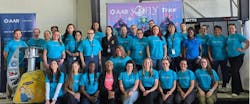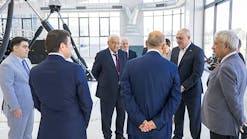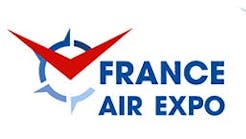The ability to accomplish any endeavor successfully and efficiently is often considered part of the unwritten job description for those of us involved in ensuring airworthiness for the global aviation community. Traditionally we have been a task-based profession benefiting from instructor-led training then becoming proficient at our jobs through repetition and in all likelihood that tradition will live on.
In the United States, Federal Aviation Regulations in Part 147 was created in the 1960s and provided direction for institutions conducting initial training for our nation’s Airframe and Powerplant (A&P) mechanics. At the time, knowledge requirements were very much in-line with the technology employed and many of the aircraft then in service had military origins. A high percentage of the rank and file employed by airlines as well as airframe manufacturers received their indoctrination to aviation maintenance in various branches of the armed forces and back then the skills required were clearly defined and could for the most part be demonstrated and practiced as part of the A&P school curriculum.
Have the basic skills really changed or just possibly evolved? Structures were manufactured using aluminum alloys concocted and heat treated to provide high strength at a low weight and we were tested on cutting, bending, utilization of special fasteners, and applying anti-corrosion products. In addition significant time was spent accomplishing fabric recovering and associated repairs. We even dabbled with composites. Of course back then it was nature’s composite otherwise known as wood and I still remember doing a scarf splice on a mockup of a wooden spar. Radial engines were still widely used and turbine technology had recently revealed the value of fan jet engines.
Our training covered the Brayton cycle and at least some of the theory associated with hydro-mechanical fuel control units. Avionics training was part of the program and consisted of about three weeks where lectures addressed radio theory, navigation instruments including gyros, importance of the pitot static systems, and autopilot principles. Radar was even mentioned with the caveat that it is best to leave that system to the specialists due to the probability of emitting large amounts of radiated energy. The program culminated with the assignment of a project to build an analog multi meter from a kit. Electronic calculators were just finding their way into the hands of the general public and I recall one of my instructors commenting that calculator technology would never find its way into aviation.
What is Needed to Achieve Success?
It is globally recognized the aviation maintenance profession is in dire straits with the worldwide fleet of aircraft growing at a rapid rate, numbers of new technicians entering the field have diminished, and those of us actively engaged struggle to keep up with ever-evolving technology. So what are the core competencies needed to achieve success today and in the future?
Several industry groups have undertaken initiatives to ensure our profession continues to evolve in a manner consistent with technology advancements. ASTM International is currently developing global standards defining what aviation personnel need to know. In addition the Aircraft Electronics Association (AEA) has worked to define the core competencies required to become an aircraft electronics technician (AET). The Aviation Technician Education Council (ATEC) has also worked directly with the FAA to update the outdated A&P training curriculum.
The U.S. Department of Labor and Statistics comprises data regarding injuries and fatalities related to various professions. For a number of years pilots have ranked within the top 10 high risk jobs. The aviation maintenance profession has fared much better. Nevertheless, safety practices and dealing with hazards is a paramount competency.
Aircraft damage as a result of foreign object ingress is still a leading cause of delayed or cancelled flights along with significant associated costs. Foreign object damage (FOD) has traditionally been associated with items ingested into engines or possibly causing damage to aircraft tires. Aircraft wiring has been subject to FOD over the years and has resulted in several noteworthy incidents.
A fairly recent concept known as electrical wiring interconnect systems (EWIS) has been adopted by numerous airworthiness agencies including the FAA and EASA. Part 25 of the Federal Air Regulations (FAR) addresses Transport category aircraft and section 1701 introduces EWIS as a requirement for new aircraft. The concept involves selection of appropriate wire type, routing, separation, and segregation of wires dealing with different transmissions such as power feeders and digital data buses. It also addresses clamping and securing by different means and most importantly covers means of ensuring continued airworthiness. Advisory Circular 25-1701 provides guidance on EWIS fundamentals and the FAA web site has several training programs to help educate technicians on the critical importance of proper aircraft wiring.
Electrostatic discharge (ESD) is a well-known phenomenon in aviation. Most technicians are aware of the importance of properly placed and maintained static dischargers on external airframe surfaces. FAA studies indicate that on average each aircraft takes a lightning strike once a year. Ordinarily with intact discharge capability these strikes are harmless. However when proper electrical bonding is not intact then the results of a lightning strike can be very detrimental.
ESD is not just a result of lightning. With the extensive use of computer technology in aircraft today it is essential for technicians to understand the disastrous effects static electricity can have on sensitive electronic circuits. It has been reported that up to 40 percent of reported equipment failures can be attributed to some type of induced ESD. Several avionics system manufacturers have developed educational programs to increase ESD awareness of aerospace personnel tasked with maintaining their equipment and have even altered equipment warranties denying claims if the fault is likely caused by ESD.
Well-intentioned and experienced aircraft technicians will make mistakes making risk management practice essential. Knowledge, understanding, and adherence will prevent common errors. Understand the safety hazards associated with human fatigue and strive to eliminate fatigue contributors in your life. Fatigue has been linked to forgetfulness, poor decision making, reduced attention, and other factors that can interfere with the ability to do the job safely. Pay particular attention to the safety and security of the items that undergo maintenance and any surrounding components that may have been disconnected or loosened (possibly to ease access) during that maintenance.
Carefully assess manufacturers' maintenance instructions and question when something either doesn’t work or doesn’t make sense. Most aircraft manufacturers have support organizations possibly including service centers where those with firsthand experience may be able to clarify questionable process or procedures to ensure that the work is completed as specified. Always refer to up-to-date instructions and manuals when performing a task, and ask questions of another qualified person if something is unfamiliar. A second set of eyes is always desirable to follow any maintenance operation to validate the functionality, safety, and security of critical items that have been touched. Thoroughness when performing routine inspections and recognizing items requiring immediate attention are addressed rather than deferred.
Tools of the Future
Our profession is one that will always require a level of proficiency with tools. There will always be a need for skilled craftsmen and preserving the tribal knowledge associated with devices such as the English Wheel, but just what tools will technicians of the future be required to master?
The list will probably include many devices currently in use such as both analog and digital multi-meters with the ability to recognize when to select one over the other. Oscilloscopes and/or scope-meters are also a necessity to master to ensure success in the predominantly digital environment found in today’s aircraft. It will be important to understand the design philosophy of maintenance diagnostic computers and their frequent intent of being troubleshooting tools - not always spelling out a solution but pointing you in the right direction. Most important is the knowledge and understanding of the soft skills such as the role of communications and interaction within a team to get the job done safely and the aircraft airworthy.





